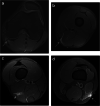Sports-related lower limb muscle injuries: pattern recognition approach and MRI review
- PMID: 33026534
- PMCID: PMC7539263
- DOI: 10.1186/s13244-020-00912-4
Sports-related lower limb muscle injuries: pattern recognition approach and MRI review
Abstract
Muscle injuries of the lower limbs are currently the most common sport-related injuries, the impact of which is particularly significant in elite athletes. MRI is the imaging modality of choice in assessing acute muscle injuries and radiologists play a key role in the current scenario of multidisciplinary health care teams involved in the care of elite athletes with muscle injuries. Despite the frequency and clinical relevance of muscle injuries, there is still a lack of uniformity in the description, diagnosis, and classification of lesions. The characteristics of the connective tissues (distribution and thickness) differ among muscles, being of high variability in the lower limb. This variability is of great clinical importance in determining the prognosis of muscle injuries. Recently, three classification systems, the Munich consensus statement, the British Athletics Muscle Injury classification, and the FC Barcelona-Aspetar-Duke classification, have been proposed to assess the severity of muscle injuries. A protocolized approach to the evaluation of MRI findings is essential to accurately assess the severity of acute lesions and to evaluate the progression of reparative changes. Certain MRI findings which are seen during recovery may suggest muscle overload or adaptative changes and appear to be clinically useful for sport physicians and physiotherapists.
Keywords: Athletic injuries; Magnetic resonance imaging; Muscle; Prognosis; Return to sport.
Conflict of interest statement
None to be disclosed.
Figures















